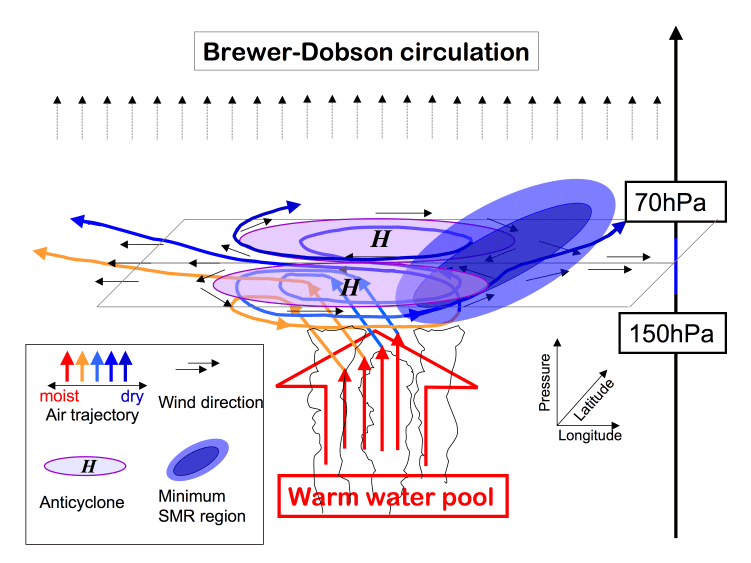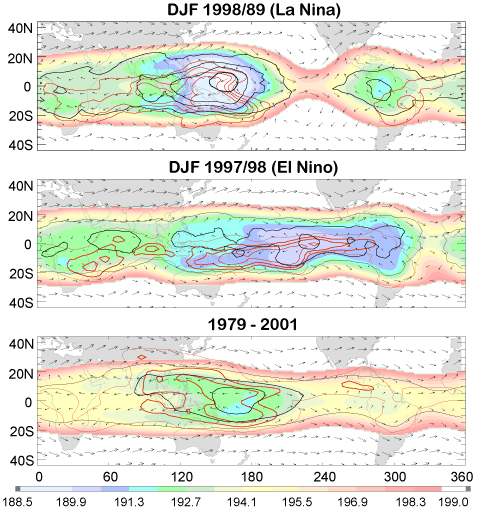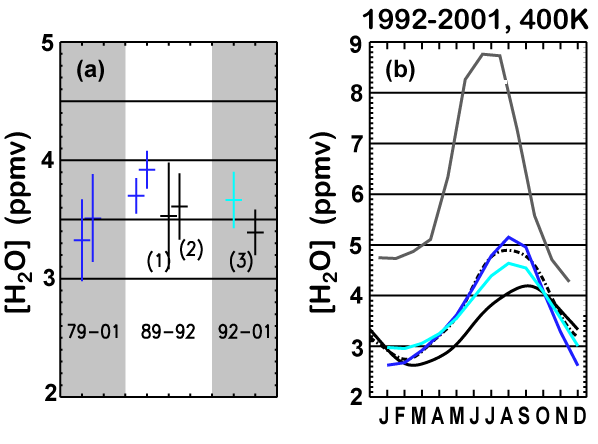 |
Stratospheric Processes And their Role in Climate
|
||||||||
| Home | Initiatives | Organisation | Publications | Meetings | Acronyms and Abbreviations | Useful Links |
![]()
 |
Stratospheric Processes And their Role in Climate
|
||||||||
| Home | Initiatives | Organisation | Publications | Meetings | Acronyms and Abbreviations | Useful Links |
![]()
Tropical Troposphere-to-Stratosphere Transport: A Lagrangian Perspective
Stefan Fueglistaler, University of Washington, Seattle, USA (stefan@atmos.washington.edu)
M. Bonazzola, European Centre for Medium-range Weather Forecasts, Reading, UK (Marine.Bonazzola@ecmwf.int)
H. Hatsushika, Environmental Science Research Laboratory, Abiko, Japan (hatusika@criepi.denken.or.jp)
Peter H. Haynes, Dept. of Applied Mathematics and Theoretical Physics, Cambridge, UK (phh@damtp.cam.ac.uk)
Thomas Peter, Institute for Atmosphere and Climate, ETH Zürich, Switzerland (Thomas.Peter@ethz.ch)
Heini Wernli, Institut für Physik der Atmosphäre, Mainz, Germany (wernli@uni-mainz.de)
K. Yamazaki, Hokkaido University, Sapporo, Japan (yamazaki@ees.hokudai.ac.jp)
Introduction
A growing body of observations and theoretical
considerations suggests that the
transition from the troposphere to the
stratosphere is gradual, rather than a relatively
sharp discontinuity at the
tropopause. In the tropics, it has been suggested
that a tropical tropopause layer
(TTL) spans the transition region from the
convectively dominated overturning circulation
of the Hadley cell to the region of
slow upwelling (primarily wave-driven) of
the lower stratospheric Brewer-Dobson
circulation. Also see the article by Ian
Folkins in this issue.
The transport of chemical tracers through the TTL is an important part of the global climate system. Air enters the stratospheric ‘overworld’ primarily in the tropics (Holton et al.,1995), and therefore processes in the TTL play a significant role in determining timescales for transport into the stratosphere of chemical species with tropospheric sources. For various reasons, among them the problem that current global-scale models cannot resolve individual convective cells penetrating the TTL, the modelling of chemical tracer transport in this region provides a formidable challenge. We have recently carried out a number of experiments with trajectory calculations based on 3-dimensional wind fields from global-scale atmospheric models and meteorological analysis datasets in order to characterize the circulation in the TTL as represented in these models and datasets. In particular, we focused on identifying typical pathways of tropical troposphere-to-stratosphere transport (TST), and their implications for stratospheric water vapour concentrations.
Here,we provide an overview of some of the
results reported by Hatsushika and
Yamazaki (2003) (henceforth HY03),
Bonazzola and Haynes (2004) (henceforth
BH04), Fueglistaler et al. (2004, 2005)
(henceforth FWP04, FBHP05) and
Fueglistaler and Haynes (2005) (henceforth
FH05). HY03 used an atmospheric general
circulation model with a resolution of
T42L50, while the other experiments used
data from the European Center for
Medium-range Weather Forecasts
(ECMWF). BH04 and FWP04 used operational
analyses with resolutions of T106/L31
and T106/L50, and T511L60, respectively,
and FBHP05 and FH05 used the ERA-40
reanalysis data with resolution T159/L60.
Circulation in the TTL and tropical TST
An intriguing result found in all experiments
is that TST-trajectories enter the
TTL predominantly over the western
Pacific. This reflects the models’
enhanced vertical transport due to convection
over the western Pacific warm
pool, and may have important implications,
particularly for the transport of
short-lived species into the stratosphere.
We note, however, that this result needs
careful interpretation given that none of
the models explicitly resolves individual
convective cells. An integration of these
results from a global perspective with
results obtained from mesoscale cloud
resolving simulations is therefore an
important and challenging task. It
remains to be seen whether the latter lead
to substantial changes of the picture
obtained from the global-scale models.
Within the TTL itself, horizontal advection
by the upper-level monsoonal anticyclones
and the equatorial easterlies plays
an important role in determining the path
of TST trajectories. A small fraction of
TST trajectories could be identified as
travelling with the northern subtropical jet
around the globe (the southern subtropical
jet appears to be more detached from
the circulation governing TST). Typically,
TST trajectories were found to travel several
thousand kilometers horizontally
from their point of entry into the TTL to
the point where they encountered their
minimum temperatures. Experiments to
determine average residence times in the
TTL show a peak of about 13 days for a
change of 10 K in potential temperature at
360 K, which is approximately the level of
zero net radiative heating derived from
radiative transfer calculations (Gettelman
et al., 2004).
The results of BH04 and FWP04 indicate
that during boreal summer the distance
travelled by the particles is shorter than
during boreal winter, but that their ascent
rate is faster during boreal winter, as
expected from the annual cycle of the
strength of the stratospheric Brewer-
Dobson circulation. These results support
the notion of Holton and Gettelman (2001)
that horizontal advection is a crucial aspect
of tropical TST. Our results, however, also
emphasize the role of zonal inhomogeneities
of vertical transport. Firstly, the
convection over the western Pacific warm
pool is the predominant source for air in
the TTL, and eventually the stratosphere.
Secondly, within the TTL this region is
characterized by enhanced upwelling and
an associated cold temperature anomaly.
Matsuno (1966) and Gill (1980) showed
that these planetary-scale features can be
understood as a stationary, planetary-scale
wave response due to localized heating in the troposphere as a result of convection
over the western Pacific warm pool.
Figure 1 (see colour insert I) provides a
schematic of tropical TST, emphasizing the
role of the Western Pacific warm pool region
and the upper-level anticyclones. During
boreal summer, the Indian/Southeast-Asian
monsoon is found to play a similar role,
although it is much less symmetric around
the equator as the convection,which plays an
important role in determining the flux into
the TTL and the pattern of horizontal circulation
within the TTL itself, is shifted significantly
to the north of the equator.
 |
Figure 1: Schematic of tropical TST, modified after HY03. The figure emphasizes the convective transport into the TTL, the upper level anticyclones and the cold anomaly around the tropopause level over the western Pacific with low saturation mixing ratio (smr).
For better resolution, please contact the SPARC Office. |
Experiments addressing interannual variability show that the largest modifications of the circulation patterns of tropical TST occur due to El-Nino/Southern Oscillation (ENSO) events. In particular, during El- Nino, convection is more homogeneous over the entire tropical Pacific, which in turn induces a homogenization of temperatures and circulation within the TTL.
Figure 2 (see colour insert II) shows the horizontal wind and temperature fields at 90 hPa from ERA-40 data during boreal winter for a strong La-Nina, a strong El- Nino situation, and the climatological mean state for the period 1979-2001. In addition, the figure shows the spatial density distribution where trajectories rising from the troposphere to the stratosphere are found to enter the TTL (red contour lines).
 |
Figure 2: Temperature (colour-coded, in Kelvin) and horizontal wind field (arrows) at 90 hPa averaged over December/January/February for a (a) La-Nina situation; (b) El-Nino situation; and (c) the climatological mean state. Red contour lines show spatial density distribution where TST-trajectories irreversibly cross the 350 K isentrope (0.025%, 0.1%, 0.2% and 0.4% of the total TST flux per 5°/2° lon/lat grid cell); black contour lines show spatial density distribution (same intervals as red contours) of the Lagrangian cold point of TST (see text). Trajectory calculations for this figure were taken from FBHP05. For better resolution, please contact the SPARC Office. |
Stratospheric water vapour
Although it has been widely accepted since
the seminal work of Brewer (1949) that the
extremely low temperatures at the tropical
tropopause constrain the water vapour flux
into the stratosphere to a few parts per million
by volume (ppmv), the details of the
dehydration processes of tropical TST
remain controversial. We therefore pursue
two goals with the trajectory calculations.
Firstly, we want to quantify the relevance of
the previously discussed large-scale spatial
structure of temperature and circulation in
the TTL for water vapour mixing ratio of
air entering the stratosphere (H2O).
Secondly, we want to quantify the degree to
which observations of stratospheric water
vapour concentrations can be explained by
model calculations that greatly simplify
cloud microphysics and mesoscale processes,
but take into account the 3-dimensional
temperature history of tropical TST as
resolved by global scale models. Of particular
interest in this context is the minimum
temperature experienced by an air parcel as
it ascends from the troposphere to the
stratosphere. FBHP05 termed this point the
‘Lagrangian cold point’, to be contrasted
with the traditional cold point tropopause.
In all experiments we found that the previously discussed circulation in the TTL is such that tropical TST trajectories efficiently sample the regions of lowest temperatures. Correspondingly, the spatial density distribution of the Lagrangian cold points as shown in Figure 2 (black contour lines) is highest in regions of lowest temperatures. These zonal temperature anomalies substantially lower H2O compared to what might be expected from zonal mean tropical tropopause temperatures. Therefore we conclude that the largescale 4-dimensional structure of temperatures and circulation in the TTL is crucial for understanding H2O. FBHP05 showed that predictions of H2O based on the saturation mixing ratio at the Lagrangian cold point of TST-trajectories agree very well with a broad range of observations, with a remaining moist bias of about 0.2 ppmv, or about 5% of H2O.
Figure 3 reproduces some results shown by FBHP05 for mean entry mixing ratios of H2O over selected periods, and the climatological mean annual cycle for the period 1992-2002. Note, for example, that the annual cycle of the model calculations based on the 3-dimensional temperature history of TST (Figure 3, cyan line) significantly improves the agreement with observations (Figure 3, black line) compared with a prediction based on tropical zonal mean cold point temperatures (Figure 3b, grey line). Remaining differences are discussed in detail by FBHP05, note for example that the obvious phase shift of approximately 1 month between the model prediction (cyan) and observation (black) is likely due to known problems of the stratospheric circulation in ERA-40 data.
FH05 further showed that for the period 1995-2002 their model predictions can explain observed interannual variability of water vapour concentrations in the tropical lower stratosphere to within measurement uncertainties. Largest modulations of H2O are found to result from the temperature perturbation around the tropical tropopause due to the Quasi-Biennial Oscillation (QBO) and due to strong El- Nino situations. Based on simulations of idealized ENSO situations, HY03 predicted that La-Nina situations should be drier than El-Nino. This was partly confirmed by FH05 in their reconstruction of H2O for the period 1979-2001. However, the interference of ENSO with other processes that affect tropical tropopause temperatures, most notably the QBO, makes it difficult to classify unambiguously the effect of ENSO, particularly La-Nina situations, on H2O.
 |
Figure 3: Comparison of model predictions and observations of stratospheric water vapour, taken from FBHP05. (a): Model predictions for concentration of water vapour [H2O]e (blue, with (left) and without (right) taking into account the seasonal cycle of the strength of the stratospheric Brewer-Dobson circulation) and tropical (30°S-30°N) mean water vapour mixing ratio at 400 K potential temperature (cyan) for the periods 1979-2001, 1989-1992 and 1992-2001. Observations (black) of [H2O]e are from Michelsen et al. (2000) (1) and Engel et al. (1996) (2), and (3) is the tropical mean water vapour mixing ratio at 400 K from HALOE. (b): Climatological mean annual cycle of model prediction for [H2O]e (blue) and tropical mean at 400 K (cyan), HALOE at 380 K (black, dash-dot) and at 400 K (black, solid), and, for reference, the saturation mixing ratio of zonal mean (10°S-10°N) cold point tropopause temperatures based on ERA-40 data (grey solid). For better resolution, please contact the SPARC Office. |
Summary
The good agreement of model predictions
with observations of stratospheric water
vapour suggests that the trajectory calculations,
and the assumption of dehydration
to the saturation mixing ratio of the
Lagrangian cold point, capture the main
processes controlling H2O. Thus, the synoptic-scale temperature history of tropical
TST apparently can explain H2O very well,
and smaller scale effects such as overshooting
convection apparently need not
be invoked at first order. Consequently, it
appears that current global-scale models
may do a better job in representing tropical
TST than might have been expected.
That notwithstanding, a comprehensive
theory explaining the spatio-temporal circulation
and temperature structure of the
TTL that encompasses all scales, from
individual convective cells to the planetary-
scale stationary wave pattern, and the
role of the stratospheric Brewer-Dobson
circulation, remains an important and
ambitious task.
References
Brewer, A.W., Evidence for a world circulation provided by the measurements of helium and water vapour distribution in the stratosphere, Q. J. R. Meteorol. Soc., 75, 351 - 363, 1949.
Bonazzola, M., and P. H. Haynes, A trajectory- based study of the tropical tropopause region, J. Geophys. Res., 109, doi:10.1029/2003JD004356, 2004.
Engel, A., C. Schiller, U. Schmidt, R. Borchers, H. Ovarlez, J. Ovarlez, The total hydrogen budget in the Arctic winter stratosphere during the European Arctic Stratospheric Ozone Experiment, J. Geophys. Res., 101, 14495—14504, 1996.
Fueglistaler, S., Wernli, H., Peter, T., Tropical troposphere-to-stratosphere transport inferred from trajectory calculations, J. Geophys. Res., 109, doi:10.1029/2003JD004069, 2004.
Fueglistaler, S., M. Bonazzola, P. H.Haynes, T. Peter, Stratospheric water vapour predicted from the Lagrangian temperature history of air entering the stratosphere in the tropics, J. Geophys. Res., 110, doi:10.1029/2004JD005516 (in press), 2005.
Fueglistaler, S., and P. H. Haynes, Control of interannual and longer-term variability of stratospheric water vapour, manuscript submitted to J. Geophys. Res., 2005.
Gettelman, A., P. M. de F. Forster, M. Fujiwara, Q. Fu, H. Vömel, L. K. Gohar, C. Johanson,M.Ammerman, Radiation balance of the tropical tropopause layer, J. Geophys. Res., 109, doi:10.1029/2003JD004190, 2004.
Gill, A. E., Some simple solutions for heat induced tropical circulation, Q. J. R. Meteorol. Soc., 106, 447 - 462, 1980.
Hatsushika, H., Yamazaki, K., Stratospheric drain over Indonesia and dehydration within the tropical tropopause layer diagnosed by air parcel trajectories, J. Geophys. Res., doi:10.1029/2002JD002986, 2003.
Holton, J. R., P. H. Haynes, M. E.McIntyre, A. R. Douglass, R. B. Rood, and L. Pfister, Stratosphere-troposphere exchange, Rev. Geophys., 33, 403 - 440, 1995.
Holton, J. R., A. Gettelman, Horizontal transport and the dehydration of the stratosphere, Geophys. Res. Lett., 28, 2799 - 2802, 2001.
Matsuno, T., Quasi-geostrophic motions in the equatorial area, J.Meteorol. Soc. Jpn, 44, 25 - 43, 1966.
Michelsen, H. A., F. W. Irion, G. L.
Manney, G. C. Toon, M. R. Gunson,
Features and trends in Atmospheric Trace
Molecule Spectroscopy (ATMOS) version
3 stratospheric water vapor and methane
measurements, J. Geophys. Res., 105, 22713
- 22724, 2000.
![]()